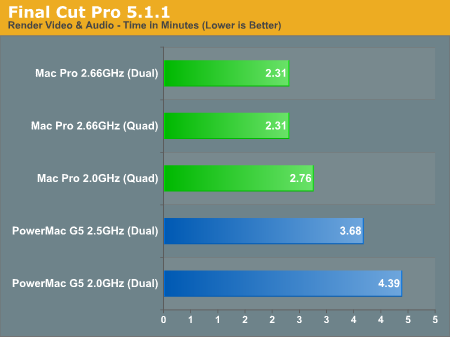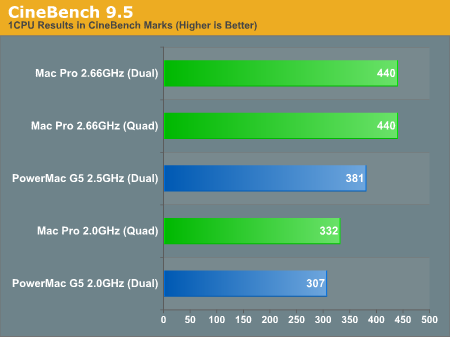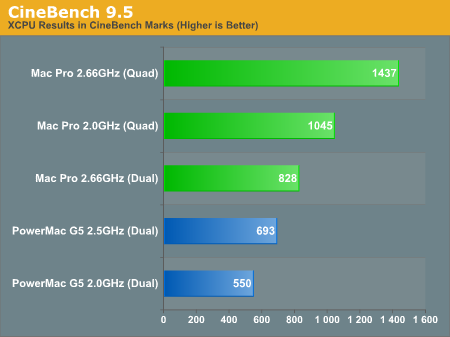Apple's Mac Pro - A True PowerMac Successor
by Anand Lal Shimpi on August 16, 2006 12:27 PM EST- Posted in
- Mac
Professional Application Performance with Final Cut Pro, Xcode and CineBench
Our first "Pro" application test uses Apple's famed Final Cut Pro 5.1.1. The test is simple, we are just rendering a video we dragged into our project:

If you spend a lot of time in Final Cut, you can't get faster than the Mac Pro. At 2.0GHz it's already faster than the PowerMac G5 (even when you extrapolate out the performance of the 2.7GHz G5).
Our next test is for all you developers out there, we're simply measuring build time using Xcode 2.4 and building our favorite OS X IM client: Adium. Compiling is very disk intensive but it's also quite CPU bound as well; while there's no benefit to quad processors when only compiling a single application there is a benefit to higher clock speeds.

The Mac Pro completely demolishes the PowerMac G5 in build time, cutting the time to build Adium almost in half. The performance improvement is tremendous and it echoes some of the feelings we've had when using Intel based Macs; anything involving I/O seems to be faster and smoother.
Our final professional benchmark is CineBench 9.5, which measures 3D rendering performance. Two versions of the benchmark are run, one that's single threaded and one that spawns as many threads as you have cores.

The single threaded test shows a reasonable advantage over the PowerMac G5, about 8% at the same clock speed. The PowerPC G5 architecture was no slouch and floating point performance was its strong point, thus even the almighty Woodcrest can't really put it to shame too much.

The multithreaded test shows the advantages of having four cores, as the Mac Pro maintains a significant lead. Note that the Mac Pro 2.66GHz held a 15.4% performance advantage over the PowerMac G5 in the single threaded test, but that grew to 19.4% in the multithreaded test. The performance scaling shows one of the advantages of Intel's shared L2 cache, making for better performance scaling when going from one to two cores.










96 Comments
View All Comments
tmohajir - Thursday, August 17, 2006 - link
I had the same question. I was debating whether to by 2 x 512MB or 1GB, and then thought it might affect performance if I went with the 1GB sticks. I think for now the best bet would be to buy 2 512s so that each branch has a channel with the same amount of memory. Then if I want to upgrade later, move all 4 512s to riser 1, and buy 2 1GB dimms when the price drops a little more and stick them in riser 2. So that way you still have 2GB total per branch.dborod - Thursday, August 17, 2006 - link
I decided to order my MacPro with 4 x 512 MB dimms so as to be able to fully utilize the available memory bandwidth. It seemed the easiest and safest approach for now.dborod - Thursday, August 17, 2006 - link
I decided to order my MacPro with 4 x 512 MB dimms so as to be able to fully utilize the available memory bandwidth. It seemed the easiest and saQuestar - Wednesday, August 16, 2006 - link
Why use MP3 encoding for performace testing in a multi cpu environment? MP3 encoding is not very threadable, and most likely is not threaded to any great extent in iTunes.Griswold - Thursday, August 17, 2006 - link
Somebody obviously has never used the multithreaded encoder of the LAME MT project. I see gains of up to 50% with that. Sure, that may not be relevant for a mac pro user, but it is proof that MP3 encoding benefits from SMT.Questar - Thursday, August 17, 2006 - link
Griswald stikes again.Yes I've heard of LAMEMT. So how's that sound quality you're getting without a bit resevoir? Pretty crappy I'll bet.
Griswold - Friday, August 18, 2006 - link
Oh give me a break nutsack. Dont pretend you know what you're talking about here, as it doesnt match your first (false) post - you obviously never used LameMT. Disabling bit reservoir may come with a certain loss of quality, but its not nearly as much as you (or the poster above) want it to make to be. I'm willing to bet 95% of the people using mp3 wont notice the difference.I'm listening to the same song encoded with standard Lame and LameMT and the quality is virtually the same. Of course, you'll now say your ears are so much better, you got so much better audio equipment and what not.. but meh, it's just questdork talking.
michael2k - Saturday, August 19, 2006 - link
The same 95% of the population who purchase tracks from the iTMS I bet :)Questar - Friday, August 18, 2006 - link
Thanks for the best laugh I've had all week!I really needed it!!
saratoga - Thursday, August 17, 2006 - link
Yeah but you also lose quality, so very few people use it.
Not exactly. LAMEMT is only multithreaded when you use parts of the MP3 standard that can be multithreaded. Typical MP3 encoding as done by lame, itunes, xing, etc simply can not be multithreaded. LAMEMT can be multithreaded because it disables certain features that are incompatable and then implements software pipelining.
The LAME devs have talked about trying to work around this problem in the past, but so far most people seem to think its just not worth the effort because the speed up is much worse then just running two copies of LAME (which gives a 100% speedup verses the 50% you saw), and of course the unresolved questions about just how badly quality would be hurt by rewriting LAME profiles from scratch to use the approach in LAMEMT.